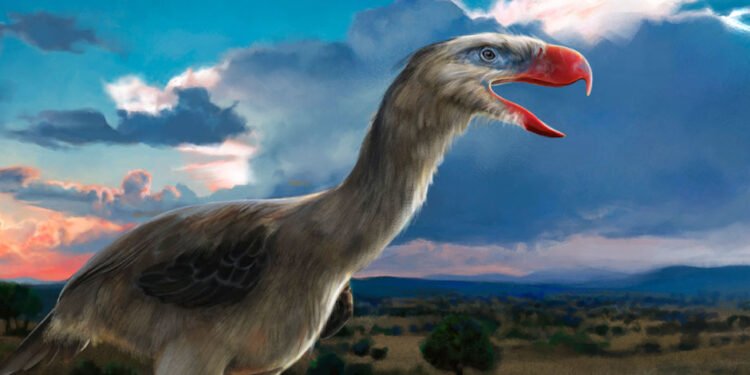Introduction: Unveiling the Terror Birds
Imagine a world where colossal, flightless birds roamed as the undisputed apex predators. Millions of years after the dinosaurs disappeared, such a reality existed in ancient South America, dominated by the Phorusrhacidae, more famously known as terror birds.
Their very name evokes the fear they inspired, and for good reason. These formidable creatures carved out a unique and terrifying niche in the prehistoric ecosystem, their imposing stature and predatory prowess leaving no doubt about their position at the pinnacle of the food chain.
More than just large birds, they were a spectacular testament to evolution’s ability to craft terrifyingly efficient hunters. Their compelling story is one of remarkable adaptation, unchallenged dominance, and an eventual, inevitable decline in a world that never stopped changing.
Physical Prowess: Anatomy of a Predator
These ancient avian giants truly commanded respect. Some species soared to impressive heights of up to nine feet, tipping the scales at several hundred pounds, making them formidable contenders against even the largest mammals of their epoch.
Their most striking features were undoubtedly their massive, hooked beaks, perfectly engineered for tearing through flesh, and robust, muscular necks designed to deliver bone-shattering blows. Their powerful legs, built for explosive speed and endurance, allowed them to relentlessly pursue prey across vast, open landscapes.
Though flightless, their wings were far from useless. Certain species sported an unusual, sharp claw on each wing, likely deployed as a weapon during intense hunts or territorial skirmishes. This potent combination of sheer size, raw strength, and specialized anatomical weaponry rendered them unmatched hunters in their domain.
Hunting Strategies: Masters of the Ancient Hunt
The terror birds were not just physically imposing; they were also cunning strategists in the ancient hunt. Their powerful legs weren’t merely for locomotion; they were finely tuned instruments for achieving incredible speeds, allowing them to outpace and run down even the swiftest prey across the expansive, open landscapes.
Once a target was cornered, their formidable beaks and incredibly strong necks became their primary weapons. Paleontologists theorize that some species would seize smaller prey with their talons, then, with brutal efficiency, repeatedly bash them against the ground, aiming to crush their skulls. It was a visceral, yet highly effective, method of dispatch.
Their diet was varied, encompassing small mammals, rodents, and reptiles, though the larger terror bird species were certainly capable of tackling more substantial game. Consider the Mesembriornis, believed to have hunted with the agility of a cheetah or the striking power of a kickboxer, using its massive talons to incapacitate victims. Meanwhile, the iconic Phorusrhacos wielded its crushing beak with devastating effect, a true master of its domain.
A Glimpse into Their World: Habitat and Era
For a significant stretch of Earth’s history, the terror birds held sway across the ancient plains and forests of South America. This continent, largely isolated from other landmasses for millions of years, became a crucible for unique evolutionary pathways, with the terror birds emerging as its undisputed apex predators.
Their formidable reign commenced not long after the dinosaurs faded from the scene, stretching across the Miocene and Pliocene epochs—a vast span from approximately 62 to 2.5 million years ago. Throughout this immense period, they masterfully adapted to a diverse array of environments, from the shadowy depths of dense forests to the sun-drenched expanse of ancient grasslands.
Within this vibrant prehistoric world, they coexisted with an astonishing menagerie of creatures. Imagine notoungulates and litopterns, herbivores that, in a remarkable feat of convergent evolution, bore superficial resemblances to modern horses, camels, and even rhinos. Alongside these grazed early carnivorous marsupials, all contributing to a rich and complex ecosystem that provided abundant sustenance for these dominant avian hunters.
Diversity and Key Species
The Phorusrhacidae family showcased an astonishing spectrum of diversity, ranging from species no larger than a modern seriema to truly colossal forms that would have made even the largest ostriches seem diminutive.
Among this varied lineage, Phorusrhacos longissimus stands out as the quintessential terror bird. Discovered in Argentina, this species embodied the terror bird ideal: a formidable, running predator armed with an imposing, hooked beak. Not to be outdone, Kelenken was another titan, soaring over three meters in height, cementing its place as one of the largest terror birds ever known.
As their evolutionary journey progressed, one particularly adventurous species, Titanis walleri, embarked on a remarkable journey. It successfully crossed into North America, utilizing the newly formed Isthmus of Panama as a land bridge. This expansion marked a significant geographical triumph, yet it also ushered in an era of new challenges and fierce competition from North American predators.
The Great American Interchange and Decline
A pivotal moment in the history of the terror birds, and indeed the entire continent, arrived with the formation of the Isthmus of Panama approximately 3 million years ago. This geological marvel forged a vital land bridge, connecting North and South America and initiating what paleontologists term the Great American Interchange—a monumental exchange of fauna between the two landmasses.
While a handful of South American species ventured northward, a far more significant wave of North American mammals, including formidable predators like saber-toothed cats and ancient canids, surged southward. This unprecedented influx of new, highly competitive carnivores drastically reshaped the delicate balance of the South American ecosystem.
The terror birds, though not instantly wiped out by this dramatic event, found themselves confronting an entirely new level of competition for resources and prey. Their decline was not a sudden, catastrophic extinction, but rather a protracted, gradual process as they struggled to adapt to a rapidly changing predatory landscape.
By roughly 2.5 million years ago, these once-dominant avian predators had largely faded from the Earth. Their ultimate disappearance wasn’t attributable to a single global cataclysm, but rather to the intricate dance of evolving environmental conditions and the relentless pressure from more adaptable mammalian carnivores.
Legacy and Modern Connections
Though the terror birds have long since vanished from the Earth, their formidable legacy as ancient world predators continues to captivate. Their fossilized remains remain a treasure trove for paleontologists, offering invaluable glimpses into prehistoric ecosystems and the remarkable intricacies of evolutionary adaptation.
While the colossal terror birds left no direct descendants of their imposing stature, the modern seriema, a long-legged bird indigenous to South America, is recognized as their closest living relative. Despite being significantly smaller and far less fearsome, the seriema exhibits certain anatomical echoes of its gigantic ancestors, a subtle reminder of a bygone era.
The saga of the terror birds stands as a profound testament to the ever-changing, dynamic nature of life on our planet. It powerfully illustrates how even the most dominant species can, over vast stretches of time, eventually succumb to the relentless pressures of evolution and environmental shifts. Their ancient reign, though concluded, continues to ignite our imaginations, firmly cementing their place as one of Earth’s most awe-inspiring avian predators.









